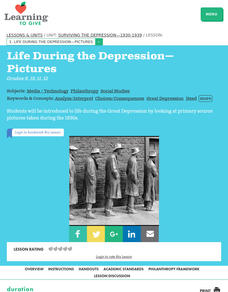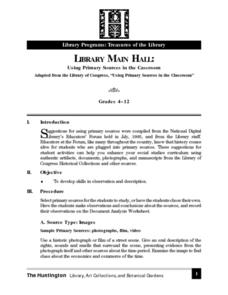Curated OER
Surviving the Depression- 1930-1939 Lesson 1: Life During the Depression- Picture
Students examine and analyze primary source documents and pictures from the Great Depression Era. They consider ways in which the suffering of the Era could have been alleviated.
Curated OER
Surviving the Depression-1930-1939 Lesson 2: Life During the Depression- Stories
Young scholars interview individuals who lived during the Great Depression era to investigate the economic hardship that was experienced. They determine the motivations of philanthropic Americans who shared and gave during this era after...
Curated OER
A Museum as Time Capsule
Students focus on museum artwork and artifacts as resources to study history and geography.
Curated OER
Who Were The Samurai?
Students discover more information about samurai. They use primary and secondary sources to explain the samurai more clearly. They examine their role in society and disregard preconceptions.
Curated OER
World War II Memories
Fifth graders utilize primary sources provided to formulate questions to prepare for an interview. Veterans and civilians who lived during World War II are interviewed by students and their work displayed on a web site.
Curated OER
Black Women in Delaware's History
Students study the number of slaves in the US in 1790 by state and answer questions. They imagine that they were an enslaved African American women and determine how their life changed when slavery ended.
Curated OER
"my Dear Little Boys..." Using Wwii Primary Documents: a Letter Home From the War
Students read letters written by soldiers during World War II in order to analyze the soldier's feelings about the war. They explain how these primary sources teach appreciation for the World War II soldier's experiences.
Curated OER
Library Main Hall: Using Primary Sources in the Classroom
Pupils choose a historical photograph or film and try to predict what happened after the photo or film in question.
Curated OER
Comparing Primary Sources from the Industrial Revolution
Tenth graders, in teams, analyze, evaluate and describe primary sources pertaining to industrialization at the turn of the century. They examine the sources and answer questions about each.
Curated OER
Introduction of Primary Sources
First graders examine a database to explain the use of primary source documents.
Curated OER
Why Did the North Fight?
Pupils evaluate interpretations of causes for Northern entry into the Civil War by accessing several primary sources.
Curated OER
The Life of Dolley Madison
Students research the life of Dolley Madison through selected website pages. They read a timeline, letters and background information and view images. They choose 10 events from her life and fill in a chart.
Curated OER
The Mystery of History - Original Sources
Students examine and discuss the differences between primary and secondary sources. They brainstorm examples of each, locate examples of primary and secondary sources on the Internet, and identify three primary sources from home.
Curated OER
Evaluate Causes of U.S. Involvement in World War II
Students examine and evaluate causes of U.S. involvement in World War II by interpreting a telegram from General Douglas MacArthur to William Allen White, the publisher and editor of Kansas' Emporia Gazette.
Curated OER
The Struggle to Organize
Students analyze correspondence and a news release regarding the Harlan, Kentucky, mine strike of 1931-1932. They use these documents to discuss the problems of organizing industrial trade unions before the New Deal.

















